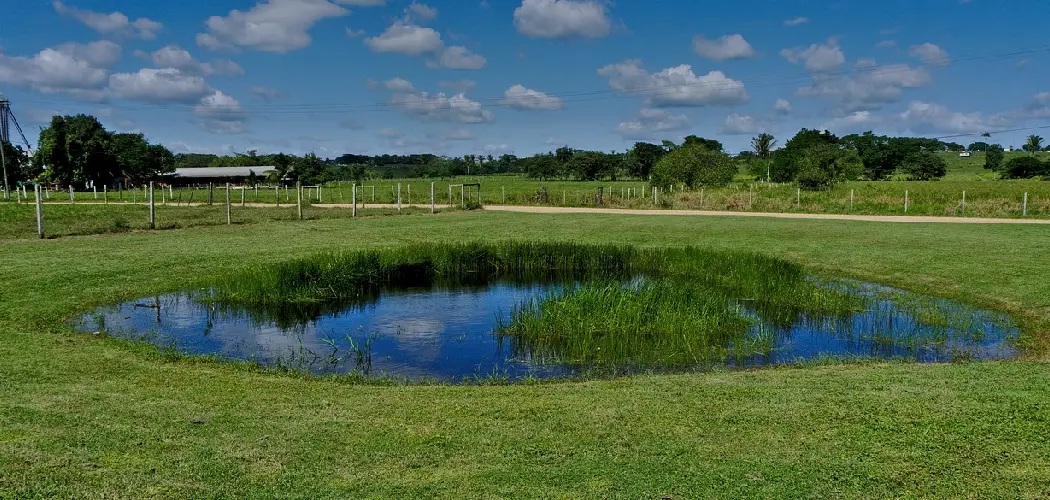Do you have a pond in your backyard, or are you planning to build one? If so, understanding the size and depth of your pond is crucial for its maintenance and overall health. Many people often overlook this important step, assuming that all ponds are created equal. But in reality, every pond is unique with its own dimensions and characteristics.
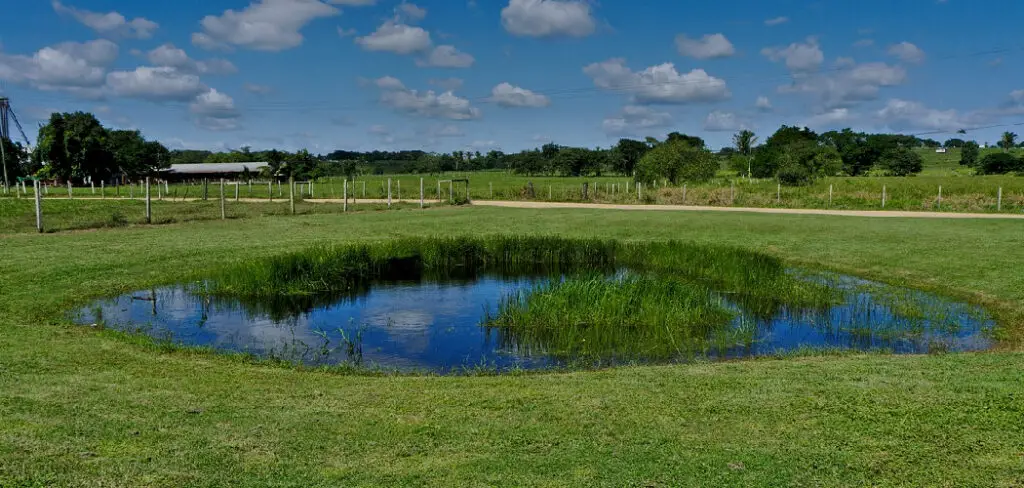
Whether you want to know how much water it can hold or what fish species will thrive in it, accurately measuring the size of your pond is key. In this blog post, we will discuss various methods on how to measure pond size and tools that can help you determine the exact measurements of your pond. So grab a cup of coffee (or tea), and let’s dive into the world of pond measurement!
Necessary Items
Before we get into the different methods, let’s first talk about the essential items you will need to measure your pond. These include a measuring tape or ruler, a long rope or string, and a marker.
- Measuring Tape/Ruler: This is the most basic tool that can help you measure the length and width of your pond accurately.
- Rope/String: A long rope or string will come in handy when measuring irregularly shaped ponds. You can also use it to measure the perimeter of your pond.
- Marker: To mark the measurements on the ground for better visualization and accuracy, you will need a marker.
10 Steps on How to Measure Pond Size
Method 1: Basic Measurement
Start by measuring the length and width of your pond using a measuring tape or ruler. Multiply the two measurements to get the total surface area of your pond in square feet. If your pond is circular in shape, use the formula: Area = π x (radius)^2, where π (pi) is approximately 3.14 and radius is half the diameter of your pond.
Method 2: Average Depth Calculation
Using a measuring tape or ruler, measure the depth of your pond at multiple points. Add all the measurements and divide by the number of points to get an average depth. Then, multiply this average depth by the surface area determined in method 1 to bring the total volume of your pond.
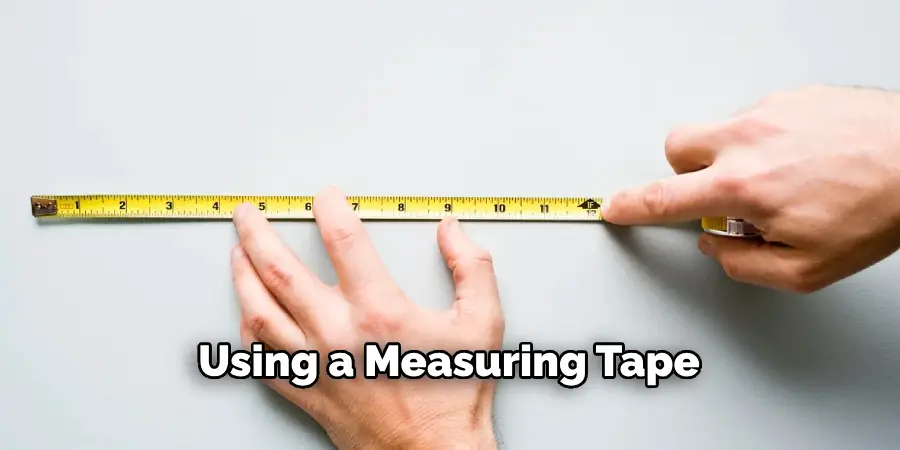
Method 3: Using a Pond Liner
If your pond has a liner, you can use it to determine the size of your pond. Lay the liner flat and measure its length and width with a measuring tape or ruler. Then, use method 1 to calculate the surface area.
Method 4: Water Displacement
Another simple method involves using water displacement to measure the volume of your pond. Fill a large bucket with a known volume of water and mark the level. Then submerge the bucket into your pond, making sure no water spills out. Measure the new water level in the bucket and subtract it from the initial mark to get the amount of water displaced. This will give you an estimate of your pond’s volume.
Method 5: Aerial Imagery
With advancements in technology, you can now use aerial imagery to measure your pond’s size accurately. Using a drone or satellite imagery, you can get a bird’s eye view of your pond and measure its length and width using the scale provided.
Method 6: Google Earth
Like aerial imagery, you can also use Google Earth to measure your pond’s dimensions. Simply enter the address of your pond and zoom in to get a closer look. You can then use the measuring tool in Google Earth to determine the size of your pond.
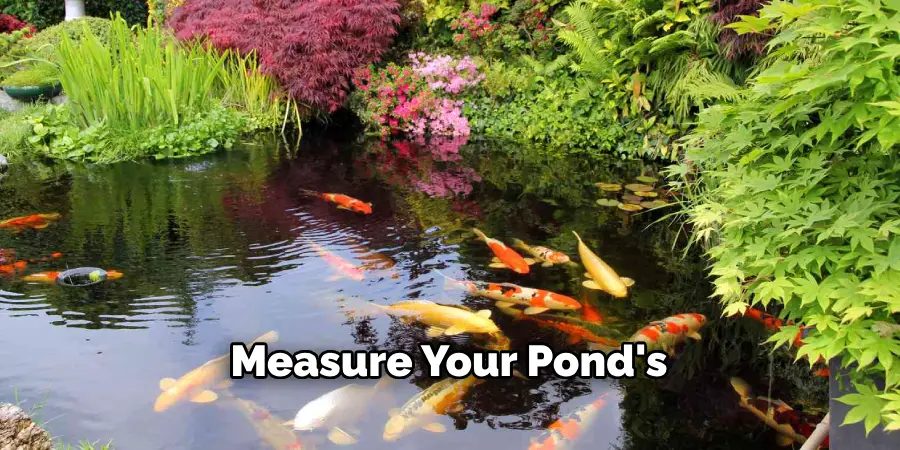
Method 7: Bathymetric Maps
If you have a deep pond, using a bathymetric map is an excellent way to measure its size. These maps provide detailed information about the depth and contours of a water body. You can purchase one or use online resources to create your bathymetric map.
Method 8: Sonar Technology
Using sonar technology, you can accurately measure the depth and volume of your pond. This method involves sending sound waves into the water and measuring how long they bounce back. The longer the time, the deeper the water.
Method 9: Water Flow Measurement
If your pond has a stream or inlet, you can measure its flow rate to determine its size. This method involves measuring the stream’s width and depth and calculating the water’s average velocity using floatation devices and timers.
Method 10: Professional assistance
If all else fails, or if you want a more accurate measurement, you can always seek the help of a professional. Many aquatic experts and pond specialists offer services to measure ponds and provide recommendations for maintenance and management.
Measuring your pond’s size is crucial for its maintenance and overall health. By following one of these methods on how to measure pond size, you can determine the exact dimensions of your pond and make informed decisions about its care. Always use the necessary tools and take accurate measurements for the best results. Now, measure your pond, and remember to share your findings with us!
8 Things to Avoid When Measuring Your Pond
When measuring your pond, you should avoid a few things to ensure accurate results. These include:
1. Measuring on a Windy Day
Measuring on a windy day can affect your results, especially if you are using aerial imagery or sonar technology. Wait for a calm day to get the most accurate measurements.

2. Not Using the Right Tools
As mentioned, ensure you have all the necessary tools before measuring your pond. Using makeshift items or correct tools can lead to accurate results.
3. Not Taking Multiple Measurements
To ensure accuracy, taking multiple measurements at different points in your pond is essential. This will account for any irregularities or changes in depth and width.
4. Forgetting to Account for Slopes
If your pond has slopes, measure the length and width at the top and bottom of the hill. This will provide a more accurate average depth and surface area.
5. Not Measuring at Different Water Levels
Pond water levels can fluctuate, so measuring your pond at different depths is crucial to get an accurate volume measurement. This is especially important for ponds with varying water levels.
6. Overlooking Obstacles
When measuring your pond, account for any obstacles, such as rocks, plants, or structures. These can affect the accuracy of your measurements.
7. Not Taking Safety Precautions
If using a boat or drone to measure your pond, always prioritize safety. Wear a life jacket and follow all necessary safety precautions to avoid accidents.
8. Neglecting Regular Measurements
Measuring your pond just once is not enough. To accurately track changes and monitor your pond’s health, take regular measurements at least once a year. This will help you identify any issues early on and take appropriate action. Being mindful of these things can help ensure accurate measurements and proper care for your pond. Happy measuring! For more pond maintenance and management information, check out our other articles. Keep your pond healthy and thriving with the right knowledge and tools. Here’s to a beautiful and well-maintained pond!
Frequently Asked Questions
How Often Should I Measure My Pond?
Measuring your pond at least once a year, preferably during the same season each time, is recommended. This will help track any changes and ensure proper maintenance.
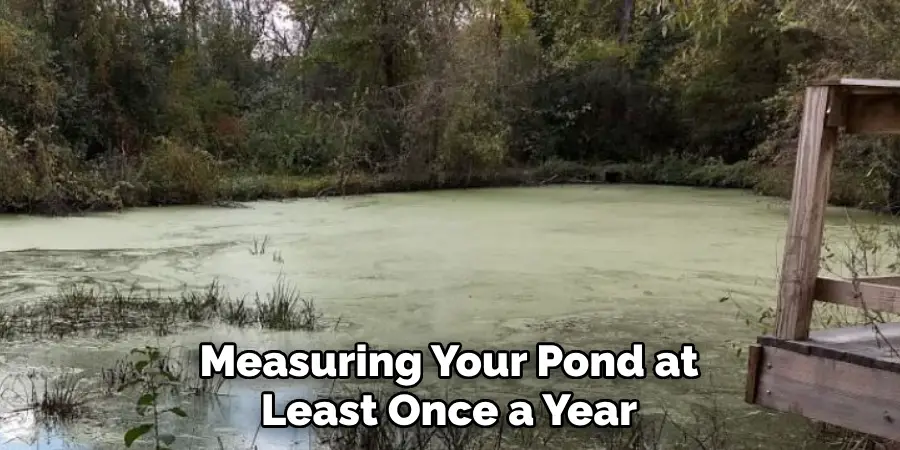
Can I Measure My Pond on a Rainy Day?
It is best to avoid measuring your pond during or after heavy rainfall, as it can affect water levels and produce inaccurate results. Wait for a clear day for more precise measurements.
Do I Need Professional Help to Measure My Pond?
While you can measure your pond using various methods, seeking professional assistance can provide more accurate and detailed results. It is also helpful in identifying any issues with your pond’s health. Overall, it is up to personal preference and the complexity of your pond.
Is It Necessary to Hire a Professional to Measure My Pond?
While you can measure your pond using the abovementioned methods, hiring a professional can provide more accurate and detailed results. It is especially recommended for larger or more complex ponds. However, if you follow the necessary precautions and use the right tools, you can also get accurate measurements on your own.
What Should I Do with the Measurements?
Once you have your pond’s measurements, you can use them to calculate its volume and surface area. This information will help determine the right amount of water treatments, fish stocking, and overall maintenance for your pond. It is also helpful in tracking any changes or issues with your pond over time.
Conclusion
In conclusion, measuring the size of your pond is an essential step for any pond owner. It gives you a better understanding of the size and capacity of your pond and allows you to maintain and care for it properly. In this blog post, we have discussed various methods and techniques on how to measure pond size for measuring your pond, including using satellite images, mathematical equations, and physical measurements.
It’s important to remember that each method has pros and cons, so it’s best to use a combination of these methods for the most accurate measurement.
Additionally, we have highlighted the benefits of accurately measuring your pond, such as determining water volume for chemical treatments and estimating fish stocking rates. By taking the time to measure your pond correctly, you are ensuring the health and longevity of your aquatic ecosystem and creating a beautiful environment for yourself and others to enjoy.

